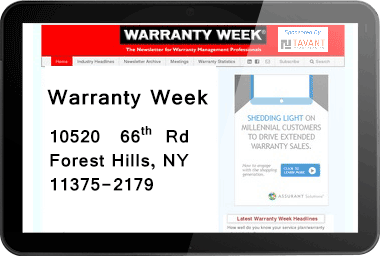December 23, 2002 |
ISSN 1550-9214 |
Online Retailers Have Different Approaches to Warranty Law Complianceby Eric Arnum, Editor The bells are ringing for online retailers this holiday season. By many measures, the number of shoppers and the amount of purchases has broken all records in recent weeks. Consumer spending online topped $2.2 billion during the week ending Dec. 13, according to comScore Networks. Consumers set a one-day e-commerce record of $288 million for non-travel goods on Thursday, Dec. 12, the research company said. A few days from now, of course, the holiday returns season begins, and a few weeks after that will mark the start of the holiday warranty claims season. How do the major online retailers deal with repair claims made under warranty? Some better than others, no doubt. Many people shop on price, but later wish they hadn't when they realize how unreliable the cheaper product is and how expensive it is to repair -- even if it's under warranty. The problem is, online retailers don't make it easy to compare products based upon reliability records or repair costs. Some don't make any information available before the sale about the manufacturer's warranty that comes with the product. Others toss off a phrase such as "one-year limited warranty" but provide no further details about whether that includes both parts and labor, and who pays for shipping. Still others go to great lengths to describe in detail the extended warranties and service plans they offer, but then they give little or no information about the basic warranty. The Law on Warranties It turns out that the lack of warranty information among online retailers is more than just an inconvenience. According to the Magnuson-Moss Warranty Act, a federal law in effect since 1975, all retailers who offer warranted goods must make copies of those warranties available to buyers before they make a purchase. One of the primary goals of the law was specifically to allow consumers to make comparisons before they buy, based upon warranty coverage or the lack thereof.
In November, the FTC's Division of Enforcement announced that it had conducted an informal Web surf of 63 prominent Internet retailers. After finding many of them deficient in some way, the FTC sent friendly reminder letters to 51 sites, alerting them that some of the things they were or were not doing might be in violation of the law. Elaine Kolish, the FTC's assistant director for enforcement, said the agency did not make the list of retailers public because at this point they're merely distributing information. "We name names when we bring cases," she said, and at this point no cases have been filed and no violations have been alleged. Many of the 51 letters detailed problems the FTC had found with online retailers' quick-ship claims, which seem to amplify themselves as Santa's deadline approaches. The agency gently reminded the retailers that it levied $1.5 million in fines to seven retailers who made quick-ship promises during the 1999 holiday season but were unable to keep them. Other letters were written in response to the FTC staff's inability to spot warranty information on certain Web sites. Kolish said that while this strongly suggests a violation of FTC rules and/or the Warranty Act, it does not on its face prove a violation. Warranty information may be available through non-online channels, she said, or it may be buried somewhere on the Web site where FTC staff didn't look. In other words, not finding it doesn't mean it's not there. Friendly Reminders The FTC said in a statement that it found: "14 of the 23 sites selling warranted products failed to provide adequate information about these warranties. The FTC�s Pre-Sale Availability Rule requires that written warranties on consumer products costing more than $15 be made available to consumers before they buy, and specifies what retailers, including mail order and catalog sellers, must do to accomplish this. The FTC staff sent letters to these sites advising them to include on their Web sites either the full text of written warranties or a general statement that warranties could be obtained free upon request and an address where the warranty can be acquired. The letters also advised how clearly and properly labeled hyperlinks can be used to provide warranty information. Warranty information must be placed near the product description, or be located clearly and conspicuously in a separate information section on the Web site. It is not sufficient for sites to summarize simply the terms of a manufacturer�s warranty." Warranty Week borrowed the list of the top 15 shopping destinations published by Nielsen//NetRatings Inc., and used it as a surfing list of our own. We looked at each site, and simulated what a person shopping for a 13-inch color television might do if they were looking for warranty information. We picked a small TV because it was potentially stocked by more retailers than other consumer electronics items. In fact, 9 of the 15 retailers sold exactly what we were looking for, and two more sold something close.
The call as to whether these Web sites met their obligations under the Warranty Act and FTC rules is a subjective one that not even the FTC staff is ready to make publicly. Lacking a law degree, we're not going to venture into that area either. We do, however, have eyesight, and our eyeballs tell us that some online retailers sell warranted goods but don't make copies of those warranties available to consumers before they buy. A summary of some of the information found (or found missing) is included below, along with links to some of the actual pages. We invite you to read the provisions of the Warranty Act and use the links below to make your own conclusions.
1. eBay Inc. (San Jose)
Individual sellers usually list the terms of their warranties, if warranties are on offer, or if they are transferrable from the original buyer to the next owner. A search of the site using the word warranty returns 5,266 matches -- for everything from a $7500 Hyster forklift still under warranty to a 99-cent factory-sealed Compaq scanner, which had yet to attract a bid at the time we searched. However, a quick scan of the list of matches reveals that all the product descriptions used the word warranty somewhere in the text. Some of the pages contained details on those warranties. Some did not. There is no easy way to tell on eBay the difference between an individual seller, a manufacturer, and a merchant, which makes it difficult to tell whether the seller normally offers warranties in the course of doing business. Individual sellers are not covered by provisions of the Warranty Act, nor are resales of used items. Only sales of new products by a professional merchant who usually engages in the business of selling those products are covered by the Act. eBay does not make those distinctions in its listings in any way.
There is no mention of the word warranty in eBay's "
Listing Policies" or in their User Agreement. The User Agreement states in section 11 that the company provides these Web pages "as-is" and without warranty, so if they break your browser, they're not responsible. Those same eBay corporate information pages list the company's address, but they include no persons' names or contact information, and they contain no information about warranties on products sold through eBay.
On a page about returning big-screen televisions, the company states that "If you are unable to locate warranty information for a particular model, contact the manufacturer. (Information to help you do that is below.)" The page also said to "...see if the problem is covered by a manufacturer's in-home service warranty. All televisions 27 inches or larger come with one." That gave us no clue about our choices for 13-inch TV warranties. We searched the electronics department for the word warranty and returned 149 results, mostly of products whose descriptions included the word warranty. None among the first 50 listings had to do with TVs. We changed course.
We shopped online for a 13-inch color TV, looking for the lowest priced model. On
a page for a specific television, in this case the Panasonic CT-13R37S 13-inch Silver TV, there were no links to any warranty information at all. Therefore, our only recourse for warranty information would be to contact the manufacturer, as Amazon advised. On the
Panasonic page listed by Amazon.com, there was no warranty information on what turned out to be the Web site for a customer support center. The customer support center's search engine found six links on the Panasonic site that contained both the word warranty and the TV's model number. We chose the first item, "Learn about the features of Panasonic's CT-13R37S - 13'' Diagonal TV with Easicon Remote," but there was no warranty information. Dead end.
3. Yahoo! Shopping (Yahoo! Inc., Sunnyvale CA)
There is a prominent link for warranties on the home page. Just under the heading for Help & Resources is a link to the Warranty Center. Alas, it turns out to be a home page for Kemper Warranty Solutions, a unit of Kemper Insurance Companies that sells service contracts and extended warranties online. Their online warranty plan quote engine gave us a price of $11.99 for a one-year extension on our TV manufacturer's warranty, and $19.99 for two years. But we hadn't yet seen the manufacturer's warranty, or the TV, for that matter. So we left the Yahoo! Shopping > Tech Center > Warranty Center and went over to the Yahoo! Shopping > Tech Center > Electronics and Camera > Television and Video > Televisions department to see what they carried. Again on this page, they offered a link to Kemper Warranty, but no link to basic warranty information.
We searched and sorted for 13-inch TVs based on price. The Panasonic CT-13R37S was in the first screenful of 10, and its link brought us to a page with price listings for the TV at online retailers JandR.com, AbtElectronics.com, dataVis.com, CityElectronics.com, and Dealznet.com. Similar sized TVs from other well-known brand names were listed on sale at Wal-Mart, Circuit City, Radio Shack, Kmart, OfficeMax, and dozens of other online consumer electronics retailers. But that's all it was -- links to retailers that sell the goods covered by warranties. Yahoo! takes
no responsibility for the activities of any merchant or for the content they post.
4. MSN Shopping (Microsoft Corp., Redmond WA)
For the record, the MSN Shopping search engine displayed a
results page for televisions that displayed pictures and model numbers for a dozen TVs under $200. A page for one of those listed models, the Panasonic CT-13R17B 13-inch color TV, explained halfway down the page, between the features and the retailer links, that it carried "
1 year parts and 3 month labor warranty, 2 year picture tube warranty."
5. WalMart.com (Wal-Mart Stores Inc., Bentonville, AR)
Perhaps some of the individual TV pages would contain some warranty information? The online store sold 11 models priced below $200, but none were 13-inch units. So we shopped for a Panasonic 20-inch model instead. Alas, there was no warranty information on that page, nor on a "Returns Policy" page. That's no surprise given that the word warranty is used only eight times on the entire Web site.
6. BestBuy.com Inc. (Minneapolis)
The Panasonic TV's product detail page was filled to the brim with warranty information. BestBuy.com places hotlinks to warranty information at the top, and again at the bottom. In the middle, the company states that the TV's warranty covers "1 year full parts, 2 years full picture tube, and 90 days labor." The top and bottom hotlinks for "warranty" and "warranty information," respectively, despite their prominent placements, don't actually bring you to any information about the Panasonic TV. Instead, the links take you to a page where the company explains that more detailed warranty information can be received by sending a letter to headquarters:
Other links carry the surfer to information on financing, shipping, returns, and optional extended service plans. The manufacturers' contact list has nothing but a toll-free (800) number for Panasonic. Therefore, the only recourse for additional details on the basic warranty would be to write a letter and wait for a response. A link for the optional Performance Service Plan, however, discloses all the details one could possibly want to see before making a purchase.
7. AOL Shopping (America Online Inc., Chantilly VA)
The "Buy at this Store" link on the Panasonic TV's page at JandR.com took us to a page that listed the length of time that the warranty covered parts, labor, and the picture tube. The detail page for CircuitCity.com, however, contained no details at all on the TV's warranty -- not even its length. Instead, it contained a link to "Request Copy of Manufacturer's Warranty," which directed the user to write a letter to headquarters in Richmond, VA.
8. ColumbiaHouse.com (New York)
9. ToysRUs.com (Toys "R" Us Inc., Paramus NJ)
10. DealTime.com (DealTime Inc., New York)
The pages for the Panasonic CT-13R17 television, including the product overview, the features page, and a page listing prices and availability at 11 different online retailers, made no mention of the word warranty. Those details are seemingly reserved for the most expensive models.
11. Dell.com (Dell Computer Corp., Austin TX)
There was nothing on the home page suggesting links to warranty information, so we entered the word warranty into the site's search engine. The search returned almost 3,000 matches, spread among categories for home, business, technical support, and elsewhere. Warranty information is everywhere. For instance, we found a 15-inch monitor (Dell Part# 06-20314), with a one-year limited warranty on parts and labor.
12. Hallmark.com (Hallmark Cards Inc., Kansas City)
13. Target.com (Target Corp., Minneapolis)
The online retailer didn't sell any Panasonic 13-inch TVs, but they did sell a TV & VCR combo. Right up top with the "product description" was the announcement that the unit carried a one-year limited warranty. While scrolling down the page looking for more details on the terms of that limited warranty, we found a series of buyer's reviews of the product (a common occurrences on Amazon.com's book pages, but unseen among the pages posted by other electronics retailers). Now we know why. The first "Spotlight Review" said their unit broke after only 2-½ months. Two of the four other reviewers also complained about breakdowns. One, using the screen name "redraven29 from San Jose" and the subject "Never Again," summed up their experience thusly:
This is a retailer's worst online nightmare. Their site gives the bare minimum amount of warranty information permitted by federal law, and then their customers report major problems with reliability. Then some of those customers report their unhappiness with the (unstated) terms of the warranty. Narratives detailing their unhappiness are posted right under the product description. It's as if your disgruntled customers are loitering around the sales desk in your place of business, offering their tales of woe to your potential customers. Bottom line: when 60 percent of the reviewers report breakdowns, and one out of five notes that he found out the hard way that the warranty doesn't cover labor, people like us are talked out of making the purchase. So we quickly clicked away to another online retailer, in this case...
14. Sears.com (Sears Roebuck and Co., Chicago)
The site also included "Advisor Guide" pages that answered questions specifically about warranties, such as "Q. When shopping for a new refrigerator, what kind of warranty should I look for?" or "Q. When shopping for a new freezer, what kind of warranty should I look for?"
The company listed 66 televisions for sale, including a Panasonic 20-inch model. Halfway down the page for that model, under the "Learn More" heading, was a hotlinked sentence, "Warranty: 2 years picture tube/1 year parts/90 days labor." Clicking on the link brings up a form that asks the question, "Would you like more warranty information?" Filling out the form sends email to the Sears Warranty center, asking the retailer to email a copy of the warranty to you. The form asks for your name and email, plus the make and model number of the unit for which you want warranty information. This is as easy as it gets. But the form also optionally asks for the serial number and "where purchased," which suggests it's geared more for post-sale usage by customers rather than pre-sale usage by window shoppers. Still, it's the first use of email autoresponders we've seen in the fulfillment of requests for warranty information. And it makes us ask why everyone else isn't doing it, especially given Sears' reputation for being less au courant than some of its competitors.
15. BarnesandNoble.com LLC (New York)
For more information about this topic, check out the FTC's consumer guide to warranties and the agency's online publication entitled "A Businessperson's Guide to Federal Warranty Law".
| ||||||||||||||||||||||||||||||||||||||||||||||||||||||||
| ||||||||||||||||||||||||||||||||||||||||||||||||||||||||


 The Federal Trade Commission adopted three rules to implement the Warranty Act: 1)
The Federal Trade Commission adopted three rules to implement the Warranty Act: 1)  eBay, "the world's online marketplace," is an auction site, where sellers pay a fee to list their items for sale. As such it is not a dealer or retailer covered by the Warranty Act, although some of its hosted sellers may be. Still, it's not up to eBay to offer warranties or not on specific products, or to list the terms of those warranties.
eBay, "the world's online marketplace," is an auction site, where sellers pay a fee to list their items for sale. As such it is not a dealer or retailer covered by the Warranty Act, although some of its hosted sellers may be. Still, it's not up to eBay to offer warranties or not on specific products, or to list the terms of those warranties.
.gif) There is no handy page for warranty information on the whole of the Amazon.com Web site. That would be OK if Amazon.com was merely a bookseller, as it was when it started out in 1995. But while books may not have express warranties and may not cost more than $15, the televisions sold in Amazon's electronics department most certainly do. Therefore, Amazon.com most definitely is an online retailer of goods normally covered by express warranties. Therefore, according to the FTC's rules, there should be instructions somewhere on the site for obtaining warranty information on TVs before potential customers make a purchase, so they can compare warranty coverage.
There is no handy page for warranty information on the whole of the Amazon.com Web site. That would be OK if Amazon.com was merely a bookseller, as it was when it started out in 1995. But while books may not have express warranties and may not cost more than $15, the televisions sold in Amazon's electronics department most certainly do. Therefore, Amazon.com most definitely is an online retailer of goods normally covered by express warranties. Therefore, according to the FTC's rules, there should be instructions somewhere on the site for obtaining warranty information on TVs before potential customers make a purchase, so they can compare warranty coverage.
 Like the well-known Yahoo! Web site directory, Yahoo! Shopping is a portal site with a web of links to information. It helps you comparison shop at leading online retailers, but it is not itself an online retailer. It's more like an online mall operator, with all the top retailers as tenants. In the case of shopping for a 13-inch TV, Yahoo! lets you quickly sort among available retailers on price, screen size, popularity, manufacturer, and other options. But it has no sort options for warranty coverage. Nowhere in its thousands of pages of product information does it list any information on manufacturers' warranties.
Like the well-known Yahoo! Web site directory, Yahoo! Shopping is a portal site with a web of links to information. It helps you comparison shop at leading online retailers, but it is not itself an online retailer. It's more like an online mall operator, with all the top retailers as tenants. In the case of shopping for a 13-inch TV, Yahoo! lets you quickly sort among available retailers on price, screen size, popularity, manufacturer, and other options. But it has no sort options for warranty coverage. Nowhere in its thousands of pages of product information does it list any information on manufacturers' warranties.
 Like Yahoo! Shopping, MSN Shopping is more like a mall operator than a retailer, with links and price comparisons for most major retailers. Although it blurs this line with links to manufacturers such as Dell Computer Corp., AT&T Wireless, and Bose Corp., which bypass the online retailers and sell direct to consumers. Then again, in the physical world a mall operator is not liable if its retailers fail to follow Warranty Act rules, so why would it be liable online?
Like Yahoo! Shopping, MSN Shopping is more like a mall operator than a retailer, with links and price comparisons for most major retailers. Although it blurs this line with links to manufacturers such as Dell Computer Corp., AT&T Wireless, and Bose Corp., which bypass the online retailers and sell direct to consumers. Then again, in the physical world a mall operator is not liable if its retailers fail to follow Warranty Act rules, so why would it be liable online?
 Wal-Mart runs an online retail Web site at www.walmart.com and a corporate Web site at www.walmartstores.com. A search of the former for uses of the word "
Wal-Mart runs an online retail Web site at www.walmart.com and a corporate Web site at www.walmartstores.com. A search of the former for uses of the word " BestBuy.com is the online retail Web site of the Best Buy discount department store chain. A search of its site using the word warranty produces
BestBuy.com is the online retail Web site of the Best Buy discount department store chain. A search of its site using the word warranty produces  Like Yahoo's and MSN's shopping portals, the AOL Shopping Web site is more like a shopping mall than a retailer. Unlike the shopping experience at those malls, however, the user of Shop@AOL remains on shopping.aol.com pages virtually until the moment they click the button to pay for the merchandise. Through handy menus on the left side, the site quickly links the user to retailers that sell small televisions. Quick navigation brought us to a choice of 68 models in the television department that were 13 inches or smaller. One was a
Like Yahoo's and MSN's shopping portals, the AOL Shopping Web site is more like a shopping mall than a retailer. Unlike the shopping experience at those malls, however, the user of Shop@AOL remains on shopping.aol.com pages virtually until the moment they click the button to pay for the merchandise. Through handy menus on the left side, the site quickly links the user to retailers that sell small televisions. Quick navigation brought us to a choice of 68 models in the television department that were 13 inches or smaller. One was a  The
The  The Toysrus.com Web site is actually the Amazon.com toy department, although there are some differences. For instance, some toysrus.com pages contain links to the Toys "R" Us corporate Web site. Like the Amazon.com online store described in
The Toysrus.com Web site is actually the Amazon.com toy department, although there are some differences. For instance, some toysrus.com pages contain links to the Toys "R" Us corporate Web site. Like the Amazon.com online store described in  The DealTime.com Web site follows the shopping mall model, connecting to a wide assortment of retailers that sell a wide assortment of goods online, including televisions. With all the flat panel, projection, and high definition TV models now on the market, the basic tube models we're looking for are now in a category called "direct view television." DealTime's descriptions of
The DealTime.com Web site follows the shopping mall model, connecting to a wide assortment of retailers that sell a wide assortment of goods online, including televisions. With all the flat panel, projection, and high definition TV models now on the market, the basic tube models we're looking for are now in a category called "direct view television." DealTime's descriptions of  Dell Computer sells televisions only if one considers computer monitors to be TVs. We do not, since they lack basic functionality such as channel tuners, but we still pursued the search further to see what the Dell.com Web site contains in the way of warranty information. Unlike ColumbiaHouse.com, the goods sold by Dell.com can be expensive, bulky, and are the types of goods that would normally be covered by a warranty. Furthermore, Dell.com is a manufacturer's site selling computer products directly to consumers, so it's both a manufacturer and a retailer. In terms of warranties, then, as Harry S. Truman used to say, "the buck stops here."
Dell Computer sells televisions only if one considers computer monitors to be TVs. We do not, since they lack basic functionality such as channel tuners, but we still pursued the search further to see what the Dell.com Web site contains in the way of warranty information. Unlike ColumbiaHouse.com, the goods sold by Dell.com can be expensive, bulky, and are the types of goods that would normally be covered by a warranty. Furthermore, Dell.com is a manufacturer's site selling computer products directly to consumers, so it's both a manufacturer and a retailer. In terms of warranties, then, as Harry S. Truman used to say, "the buck stops here."
 Hallmark.com sells greeting cards, small gifts, CDs, flowers, and other items not normally associated with a warranty. Sales of red roses by the dozen can easily cost upwards of $80, but no information is offered about any specific guarantee of delivery time, freshness, etc. We assume there's an implied warranty of merchantability -- that they're fresh red roses and not naked stems -- but there's no confirmation of this online. The
Hallmark.com sells greeting cards, small gifts, CDs, flowers, and other items not normally associated with a warranty. Sales of red roses by the dozen can easily cost upwards of $80, but no information is offered about any specific guarantee of delivery time, freshness, etc. We assume there's an implied warranty of merchantability -- that they're fresh red roses and not naked stems -- but there's no confirmation of this online. The  Like the ToysRUs.com Web site, the Target.com shopping site is "powered by Amazon.com." As such we had low expectations about finding any information about warranties on the site. However, we were surprised and amused by what we found.
Like the ToysRUs.com Web site, the Target.com shopping site is "powered by Amazon.com." As such we had low expectations about finding any information about warranties on the site. However, we were surprised and amused by what we found.
 Sears.com, the online arm of the esteemed and established retailer, uses the word warranty hundreds of times on its Web site. The main electronics page carries a banner, "
Sears.com, the online arm of the esteemed and established retailer, uses the word warranty hundreds of times on its Web site. The main electronics page carries a banner, " The Barnes & Noble Web site sells some CDs and DVDs, but their mainstay remains books, which are normally not covered by warranties. A search of the site using the word warranty returned
The Barnes & Noble Web site sells some CDs and DVDs, but their mainstay remains books, which are normally not covered by warranties. A search of the site using the word warranty returned 

